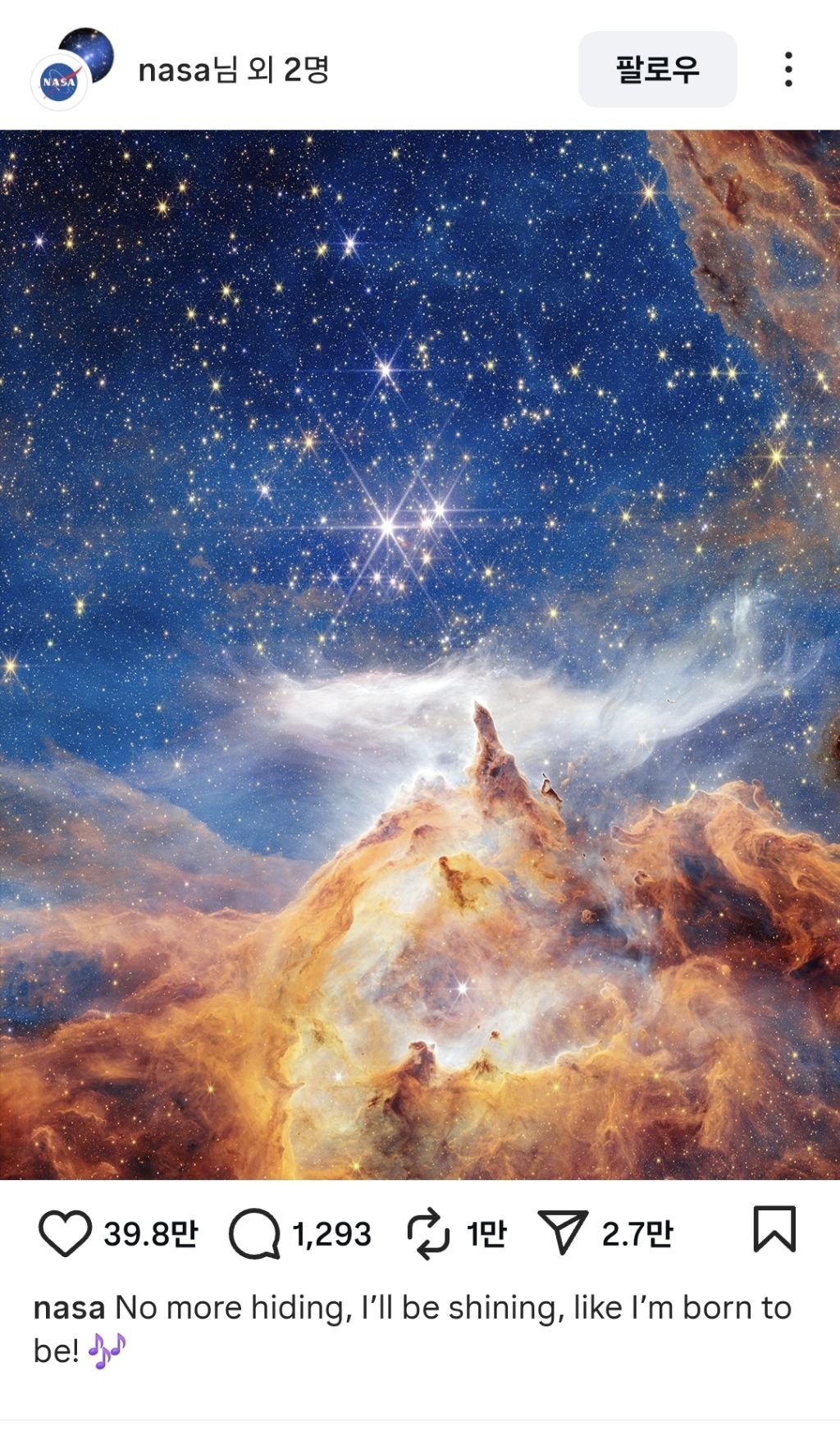|
|
- 모두가 건전하게 즐길 수 있는 유머글을 올려주세요.
- 유게에서는 정치/종교 관련 등 논란성 글 및 개인 비방은 금지되어 있습니다.
| Date |
2025/09/07 01:28:32 |
| Name |
VictoryFood |
| File #1 |
1.jpg (341.7 KB), Download : 45 |
| 출처 |
나사 인스타 |
| Link #2 |
https://www.instagram.com/p/DOLu07qE8E5/ |
| Subject |
[기타] NASA 인스타 근황 |

No more hiding, I’ll be shining, like I’m born to be! ????
Our @NASAWebb Space Telescope captured newborn stars forming in clouds of dust and gas (colored golden and orange in this image) in a star-forming region called Pismis 24. Though these clouds can hide stars by trapping visible light within, in the infrared, the stars shine through the nebula and together appear to glow.
In the center is Pismis 24-1, an object formerly thought to be a single massive star, now known to be at least two stars. At 74 and 66 solar masses, they are some of the most massive and luminous stars ever seen. They are blasting out scorching radiation and stellar winds that are carving a cavity into the wall of the star-forming nebula clouds below and at above right.
The fierce forces shaping and compressing the spires in the glowing gas at the bottom of the scene cause new stars to form. The tallest spire spans about 5.4 light-years from the bottom of the image to its top. More than 200 solar systems could fit into its tip.
A note on the color choices here - cyan indicates hot or ionized hydrogen gas being heated by the massive stars. Dust molecules (similar to smoke on Earth) are represented in orange. Red signifies cooler, denser molecular hydrogen - the darker the red, the cooler the gas. Black is the densest gas; it is not emitting light. The wisps of white are dust and gas scattering starlight.
Pismis 24 is one of the closest sites of massive star birth, giving scientists rare insight into the properties of hot young stars and how they evolve.
Read more at the link in @NASAWebb's bio.
Image description: A blue and black sky filled with stars covers about two thirds of the image. The stars are different sizes and shades of white, yellow, and orange. Across the bottom third is a mountain-like vista with spire-like peaks and deep valleys. These “mountains” appear in shades of orange, yellow, and brown. The spires go up and meet a wispy, white cloud that stretches horizontally across the scene. At the top, right corner of the image, a swath of orange and brown structure cuts diagonally across the sky.
Image credit: NASA, ESA, CSA, STScI
(제미나이 번역)
NASA의 웹 우주 망원경이 포착한 이 사진은 피스미스 24라는 별 탄생 영역에서 먼지와 가스 구름(황금색과 주황색으로 표현) 속에서 갓 태어난 별들이 형성되는 모습을 담고 있습니다. 이 구름들은 가시광선을 가두어 별들을 숨기지만, 적외선에서는 별들이 성운을 뚫고 빛나며 함께 빛나는 것처럼 보입니다.
중앙에는 한때 거대한 단일 별로 여겨졌던 피스미스 24-1이 있습니다. 이제 이 별은 최소 두 개의 별로 이루어져 있다는 사실이 밝혀졌습니다. 이들은 각각 태양 질량의 74배와 66배에 달하며, 지금까지 관측된 별들 중 가장 거대하고 밝은 별에 속합니다. 이 별들은 맹렬한 복사와 항성풍을 내뿜으며 아래와 위 오른쪽의 별 탄생 성운 벽에 공동(空洞)을 만들고 있습니다.
장면 하단의 빛나는 가스 속 뾰족한 봉우리들을 깎고 압축하는 강력한 힘은 새로운 별들이 형성되는 원인이 됩니다. 가장 높은 봉우리의 길이는 이미지 하단부터 상단까지 약 5.4광년에 달합니다. 그 끝부분에는 200개가 넘는 태양계가 들어갈 수 있을 만큼 거대합니다.
색상 선택에 대한 설명: **시안(청록색)**은 거대한 별들에 의해 가열되는 뜨겁거나 이온화된 수소 가스를 나타냅니다. 지구의 연기와 비슷한 먼지 분자는 주황색으로 표현되었습니다. 빨간색은 더 차갑고 밀도가 높은 분자 수소를 의미하며, 빨간색이 진할수록 가스는 더 차갑습니다. 검은색은 빛을 방출하지 않는 가장 밀도가 높은 가스입니다. 흰색은 별빛을 산란시키는 먼지와 가스의 얇은 띠입니다.
피스미스 24는 거대한 별이 탄생하는 곳 중 가장 가까운 곳 중 하나로, 과학자들에게 뜨겁고 젊은 별들의 특성과 진화 과정에 대한 귀중한 통찰력을 제공합니다.
더 자세한 내용은 NASA 웹의 링크에서 확인하세요.
이미지 설명: 이미지의 3분의 2 정도를 차지하는 푸르고 검은 하늘은 별들로 가득 차 있습니다. 별들은 다양한 크기와 흰색, 노란색, 주황색을 띠고 있습니다. 아래 3분의 1 지점에는 뾰족한 봉우리와 깊은 계곡이 있는 산맥 같은 풍경이 펼쳐집니다. 이 '산'들은 주황색, 노란색, 갈색을 띠고 있습니다. 이 봉우리들은 위로 뻗어 올라가 장면을 가로지르는 얇고 하얀 구름과 만납니다. 이미지 오른쪽 상단에는 주황색과 갈색 구조물이 대각선으로 하늘을 가로지르고 있습니다.
|
통합규정 1.3 이용안내 인용
"Pgr은 '명문화된 삭제규정'이 반드시 필요하지 않은 분을 환영합니다.
법 없이도 사는 사람, 남에게 상처를 주지 않으면서 같이 이야기 나눌 수 있는 분이면 좋겠습니다."
|